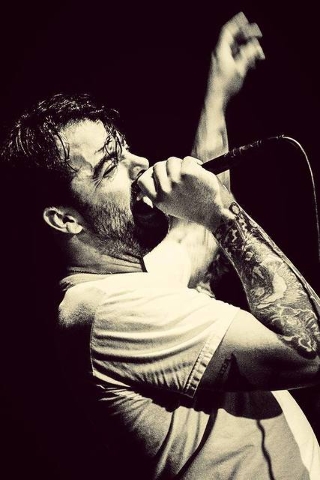Living Las Vegas loca
Stunningly prolific, Franky Perez has produced an enormous volume of music in the past dozen years.
In that time, he’s played with a staggering number of marquee musicians. And staggering is precisely the right superlative: Although many musicians inflate their bios to make themselves seem more impressive, there’s no need for Perez to fabricate anything, as you’ll see below.
Since being a member of Soul Groan, a long since forgotten local outfit he played in with fellow Las Vegan Branden Campbell from Neon Trees, the short list of acts he’s performed with includes Scars on Broadway with members of System of a Down, the Forest Rangers, Sons of Anarchy’s house band, and Apocalyptica, the Finnish band he fronts now. Just getting started here.
In between those high-profile stints, he’s performed with Slash from Guns N’ Roses, worked on several projects with Dave Kushner from Velvet Revolver, including DKFXP and Pusher Jones, been part of the Ducati All-Stars with the Cult’s Billy Morrison, Steve Jones of the Sex Pistols, Billy Idol guitarist Steve Stevens, Jason Bonham and Mark McGrath, and collaborated with fellow Vegas act, the Crystal Method.
Oh, and in the midst of all this, Perez somehow maintained an admirable solo career, releasing three albums of his own music. And that’s where you’ll find his most arresting work.
An incredibly expressive songwriter, Perez has been painting poignant portraits since his first record on songs such as “Something Crazy,” with a narrative that deals directly with domestic violence, from a slightly different perspective, that of a friend harboring an unrequited infatuation, who can no longer stand by and watch the woman that he loves be so woefully mistreated.
A vivid vignette of vulnerability, the tune opens with a couple of friends, sitting in the backseat of a car, opening up to each another, with one wondering why they didn’t end up together.
After a quick refrain of the chorus, which pivots on the kind of double-barreled double entendre that’s country’s stock-in-trade, Perez portrays the profound pathos of being in an abusive relationship with a pronounced immediacy: “She wears makeup to hide the scars/Got bruises up and down her arms/And the coward’s name tattooed on her wrist/She says that she’s afraid to leave/She says someday he’s gonna kill me/’Cause when he’s drunk he talks with his fists.”
Intensely affecting, “Something Crazy” is a hallmark of Perez’s songwriting. Arriving precociously, armed with songs like that, it’s easy to see why Lava, the Atlantic Records imprint helmed by famed artist-and-repertoire man Jason Flom, saw fit to add Perez to its roster early in the past decade. Of all the material he’s produced over the years, though, no piece of music perhaps captures Perez’s essence — or gives you a glimpse of his tumultuous trajectory — quite as deftly as “Die In Vegas.”
The song, like all the best Perez tunes, grabs you right out of the gate, as Perez eloquently sets the stage with an evocative economy of words:
“I was born in Vegas in ’76/In the middle of the desert, shadow of the Strip/My daddy waited tables; he worked the swing shift/Mom’s in the casino, losing all his tips/You could flood this desert with all the tears she’s cried/Driving downtown in mama’s LTD/Looking for pawn shops to take her wedding ring…”
One of his best songs, “Die in Vegas” namechecks Interstate 15 before continuing on with a chorus that finds Perez desperately declaring, “When it’s my time, I’m going to die in Vegas/Right there on the pavement, under the neon, down on Fremont Street,” before imploring, “So don’t you let me die thirsty, bring me some Wild Turkey, throw it on a gurney/Roll me down the boulevard, when it’s my time.”
With so many distinctive details — including other telling turns of phrases such as, “I have a 16-gauge buried underneath my chin/Dancing with the devil, praying Jesus cut in” — you get the sense that the tune was ripped right from the pages of Perez’s life. It was, Perez reveals. The ominous ode is autobiographical and was written in the last lonely, burning embers of an epic bender, in an odd tuning exclusive to that song.
“I had probably been up for three or four days,” Perez remembers. “It was early in the morning, and the reason that I’m in that alternate tuning is I was so inebriated, I was so messed up, that I could not tune the guitar standard. I could not figure it out.
“My mind wouldn’t work correctly. So I literally got it to a place where it was a chord, and started strumming, and that song came to me and the lyrics came to me, and memories flooded in. It was a very desperate morning, and I wrote that song in probably ten minutes. And then I passed out and woke up in the same spot, with the guitar.”
It was a dark time for Perez, who has struggled with alcoholism and addiction for almost as long as he’s been making music professionally. He’s been sober in stints during this time, including the past two years.
Although “Die In Vegas” has never been officially released, there’s a pair of clips of Perez performing it posted online, the most compelling of which was filmed by the photographer who shot the stills for the singer’s solo debut and was working a project inspired by Alan Lomax’s famed field recordings.
The footage, which is stark and shot in one take, marks Perez’s favorite version of the song. In the clip, he looks as if he’s lived the storyline, even though he’d been sober then for six years. He relapsed shortly after it was shot.
“I started my life over in L.A.,” he says. “I didn’t have a record deal. I was up for the Velvet Revolver gig, and I rented a little studio in the valley. It was just a lonely place. I lived in a garage turned into a studio apartment.”
“I used to believe that wholeheartedly,” he adds. “I used to believe that you had to live it, really, to a fault. And then I got sober and started to deal with my personal issues. My addiction has always been — I’ve always medicated feelings — I was never a party guy, like, ‘Oh, let’s go to Hakkasan.’ That wasn’t my thing. My thing was I was in a room alone, using to escape things that I hadn’t dealt with. So I believed that you had to live that.
“But then I got sober and did a lot of work,” he goes on. “I’ve been talking to a therapist regularly. I went to rehab. I lived in sober living. I really handed over all power, and I believe the writing in retrospect, has been some of the most powerful stuff I’ve done, because I can really articulate what I want to say. Are you less vulnerable?
“Like are you willing to take less chances when you’re messed up? Yeah, absolutely. But if you can reach a place like that in sobriety, man, you’re unstoppable.”
And so that’s where Perez finds himself now, clear-eyed and seemingly unstoppable, as he continues to play and pen new music, on his own, with Apocalyptica and with “Sons of Anarchy” composer Bob Theil Jr., who’s enlisted him to work on Kurt Sutter’s next project, the Bastard Executioner. But judging from Perez’s latest album, “ADDICT,” his own music is still the most compelling, as songs such as “Stay” effectively illustrate.
Still autobiographical, the words are as earnest and incisive as ever. When he sings, “I wrote your name in wet cement, right there next to mine,” those opening lines are literal, referring to sidewalks lining Sam Jonas Drive near South Buffalo Drive — naturally, Perez’s hometown figures prominently into the lyrics. Las Vegas isn’t just where he’s from, it’s who he is. Although he’s traveled the world playing music, Perez always comes back home.
This is the place that shaped him, from his elementary years at Garside to high school at Bonanza — well, before he got kicked out, that is, for accidentally punching the football coach, and ended up at opportunity school. And it’s where all his best memories reside — watching the Rebels parade on Fremont with his dad after the Final Four to getting to throw out the first pitch as a fifth-grader at a baseball game at Cashman Field.
“It was incredible,” he remembers. “That was my first experience with a massive cheering crowd.”
Read more from Dave Herrera at bestoflasvegas.com. Contact Dave at dherrera@reviewjournal.com.
PREVIEW
Who: Franky Perez
When: 10 p.m. Saturday
Where: The Lounge at Palms, 4321 W. Flamingo Road
Admission: Free
702-944-3200





























